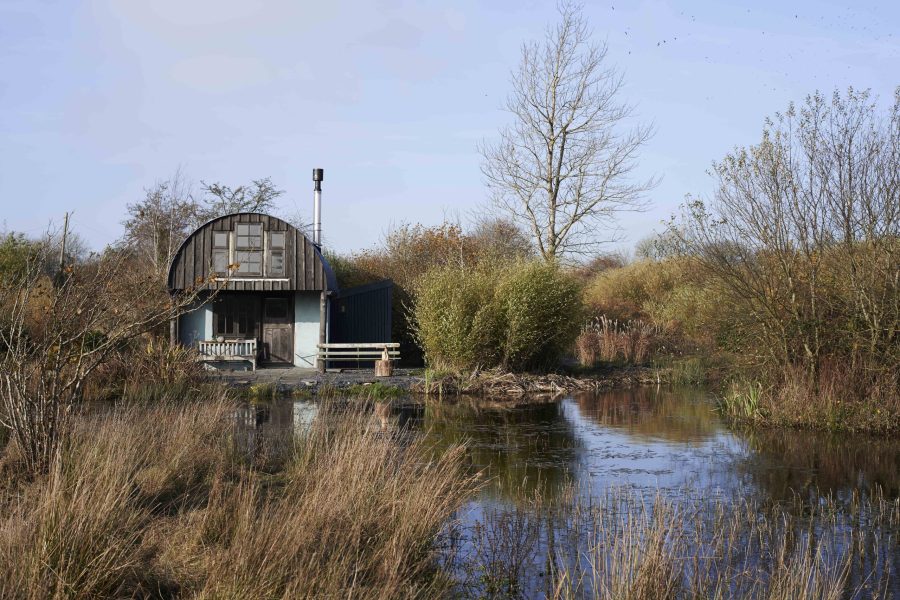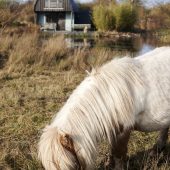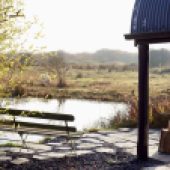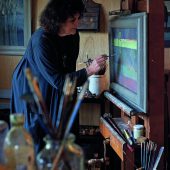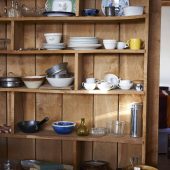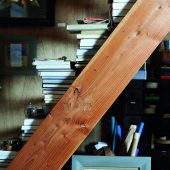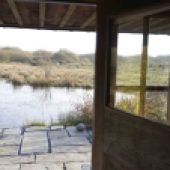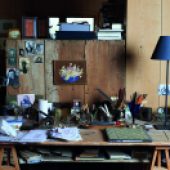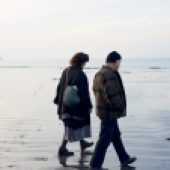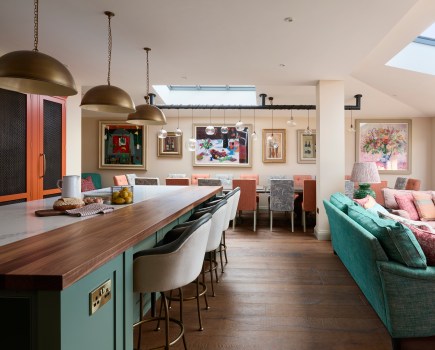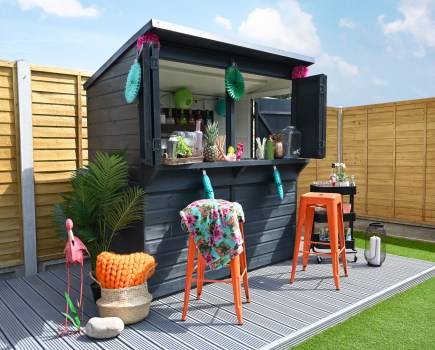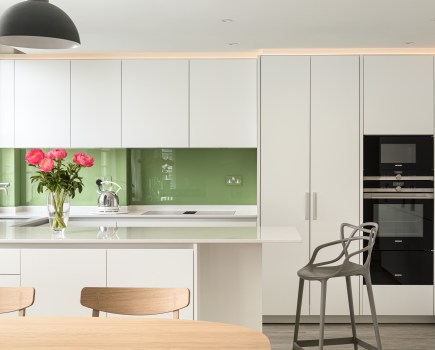Annette de Mestre and Hugo Colville have created an innovative base for their artistic endeavours from two barrel-vaulted barns on the Pembrokeshire coast. Words: Alex Reece. Photographs: Paul Viant
It was the peacefulness and wildness of the Pembrokeshire coast that drew Neti and her artist/poet partner Hugo Colville to the area 18 years ago. The pair – who met through a theatre Neti was running in Herefordshire (Hugo initially trained as an actor) – were searching for a place to settle, and looked first in France, then Ireland, before friends suggested a 40-acre smallholding outside the seaside town of Newport in West Wales.
‘We were desperate for land and to put our roots down,’ Neti recalls, as she describes their first visit to the property, a 150-year-old farm, where the previous owners had kept cattle and bred turkeys. ‘It was very overgrown and the cottage needed a lot of remedial work,’ she says. Nonetheless, the couple fell in love with the place, and the long, winding track that leads to it, from which the Dinas Head peninsula and Newport Bay are visible. ‘It had a kind of wildness to it,’ adds Hugo. ‘And it’s close to the sea. I like living on the edge.’
A CORRUGATED CHATEAU
After first restoring the farmhouse cottage (now a holiday let), the couple turned their attention to its outbuildings: two open-sided barns with rusted, barrel-vaulted roofs, to create some live/work space. The ‘Little Barn’, which they renovated themselves with the help of friends, became Hugo’s writing den – a place for him to craft his books (published through his and Neti’s own company, Out of a Notebook Publishing), and his distinctive line drawings in pencil and charcoal. Currently, he’s writing a book about lines, but past subjects have included buttons and pockets, and pens and pencils. They are a mixture of ‘poetry, philosophy and documentary’, he says.
The Little Barn has a cabin-like interior, with pitch-pine windows and floors, and an oak door – ‘We picked up things from houses that were being demolished,’ says Neti – and a simply furnished kitchen/living area, heated by a wood-fired range. The double-height, curved ceiling and peephole windows to the side add to the feeling of light and space.
‘It was very nice to work in,’ says Hugo, who sat at a desk overlooking the pond, which teems with wildlife – ducks, moorhens, dragonflies, frogs and an otter are all seen here. ‘Every time you look up you can see some little ducks swimming by – it was sometimes a little distracting!’
Following a successful joint exhibition in London, Neti and Hugo decided to refurbish the ‘Big Barn’ on the site, too, recladding and insulating it to create an expansive studio for them both. As with the Little Barn, the artists designed the conversion themselves and worked with friends to achieve it, using plain timber cladding on the inside, to keep the character of the metal structure intact. ‘In a sense it is quite primitive,’ Hugo says, although both enjoy the luxury of the 50-foot-long space in which to focus on their numerous creative projects. ‘We call it our corrugated chateau,’ he jokes.
DRAWN TO THE SEA
Hugo has now established his workspace in the entire upper floor of the Big Barn, a vast, vaulted study, which he describes as: ‘like a cavern, chock-full of books’. Here, he dedicates himself to writing and drawing in the mornings and evenings, before spending around three hours every afternoon tending to the land ‘to keep it nurtured’. Employing his past training as a gardener and tree surgeon, he uses a hand-scythe to keep unwanted vegetation in check, although the couple also have the help of a few shaggy ponies provided by the Pembrokeshire Coast National Park.
Neti, meanwhile, paints on the ground floor of the BigBarn in winter, which is warmed by a sizeable, freestanding, wood-burning range. The muted colour palette of Welsh mist is a constant in her work, as are birds and the sea. ‘I used to come here years ago when I was young and paint the landscape from life,’ she says. ‘The coastline is amazing. It’s jagged, with lots of lovely coves, and seals and dolphins.’
Adjacent to where Neti paints is a bookbinding press, which she uses to produce handmade notebooks. The remainder of the studio area is filled with artistically curated collections, such as the tiny homegrown posies from Hugo’s ‘Buttonhole Nursery’, displayed in vintage medicine bottles, or his astounding ‘Button Museum’ – a covetable hoard of vintage fastenings – housed in a 17th-century travelling cupboard, an heirloom that first belonged to Henry, Prince of Wales, son of James I.
PASSING IT ON
The duo’s most recent project was to convert the Little Barn into self-catering accommodation. This they did by annexing a slate-tiled shower room, warmed by under-floor heating. There is also a king-size bed in the bedroom to the rear, which is decorated with vintage French furniture. It has no TV, not even a fridge (a cool box is provided in the summer), but the guestbook is full of praise for the silence, the opportunities to star-gaze or to take the rowing boat out on the pond. One describes their stay here as a ‘recipe to restore your soul’.
Guests are invited to visit Neti and Hugo’s Big Barn, where they can purchase prints, books, paintings, cards and picnic goods, or they are welcome just to have a look around. The couple’s unique, refreshing way of seeing things is infectious, and they’re happy to pass it on. ‘It’s so lovely to share the place, because it’s fulfilling for us – otherwise you feel a bit selfish,’ says Hugo. ‘And everybody seems to be so appreciative, which makes it all worthwhile. It’s nice to share an experience of a way of being.’
The Little Barn is available to let through Under the Thatch, as is the cottage Ty Glas. Call 0844 500 5101 or visit underthethatch.co.uk. For more on Neti and Hugo’s work, see annettedemestre.co.uk and hugocolville.co.uk.
Nett and Hugo's inspiring places
• The closest place on the coast, Ceibwr Bay, is a little bay with rocks and a lovely walk, which takes you to a geological feature called the Witches’ Cauldron. On the right sort of day, the water shoots up like a geyser, which is very exciting.
• Ty Canol Woods is an ancient wood in the area, well known for having a great diversity of lichens. It has cairns at the top and an ancient burial ground at the bottom.
• Newport is a little seaside town where you can buy good chocolate brownies from Loulou’s Café (Market Street, 01239 820777, loulouscafenewport.com). You can also visit the boats around the harbour at Parrog.
• The beautiful Carningli Mountain has its own legend. In the 6th century, St Brynach used to walk there every day from Nevern to the top of the mountain to have a chat to the angels (Carningli means ‘Mountain of the Angels’).

